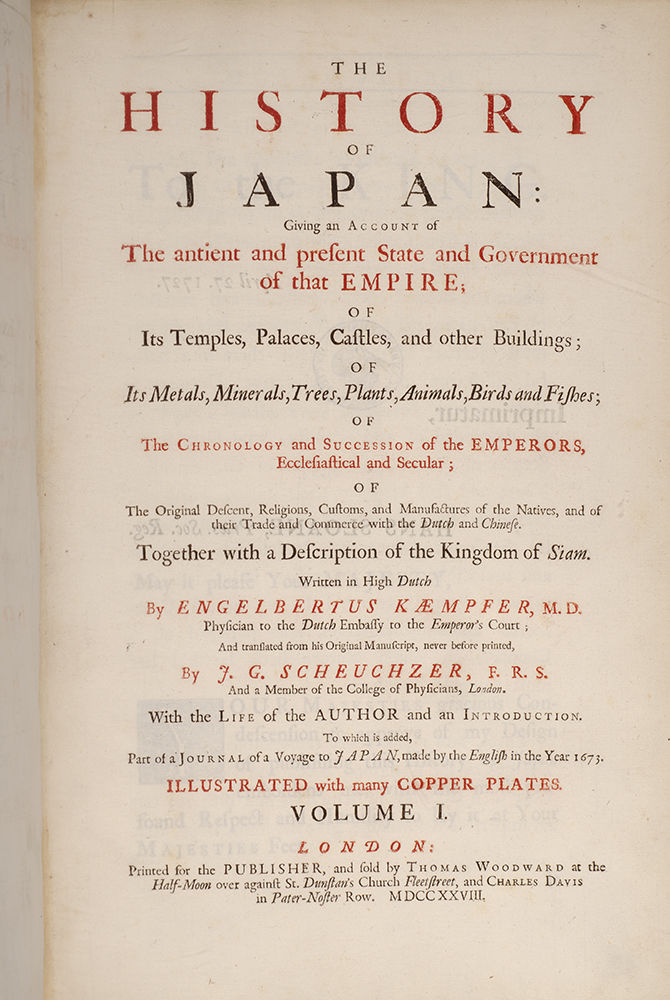The History of Japan: Giving an Account of The antient and present State and Government of that Empire;
KÆMPFER, Engelbertus; SCHEUCHZER, J.G., translator
- Publisher: London: Printed for the Publisher, and sold by Thomas Woodward… and Charles Davis, 1728
London: Printed for the Publisher, and sold by Thomas Woodward… and Charles Davis, 1728. One of the Most Important Eighteenth-Century Works on Japan
The First Scholarly Treatment of Japan in any Language
KÆMPFER, Engelbertus. The History of Japan: Giving an Account of The antient and present State and Government of that Empire; Of Its Temples, Palaces, Castles, and other Buildings; Of Its Metals, Minerals, Trees, Plants, Animals, Birds and Fishes; Of The Chronology and Succession of the Emperors, Ecclesiastical and Secular; Of The Original Descent, Religions, Customs, and Manufactures of the Natives, and of their Trade and Commerce with the Dutch and Chinese. Together with a Description of the Kingdom of Siam. Written in High Dutch…And translated…by J.G. Scheuchzer… With the Life of the Author and an Introduction. To which is added, Part of a Journal of a Voyage to Japan, made by the English in the Year 1673. Illustrated with many Copper Plates. London: Printed for the Publisher, and sold by Thomas Woodward… and Charles Davis, 1728.
Second edition in English - Complete with the Appendix on the English Voyage to Japan.
Two folio volumes (13 5/16 x 8 5/8 inches; 338 x 219 mm.). [12], lii, [1]-391, [1, blank], [4, explanation of the plates]; [4], 393-612, 75, [1, blank], [2], 11, [1, blank], [4], [6] pp. With two title-pages in red and black, list of subscribers in Volume I, contents to both volumes, index at end of Volume II, and two appendices in Volume II, including the separately titled appendix on the English voyage to Japan (first included in this edition). Complete with engraved title-page (dated 1727) in Volume I and forty-five engraved plates, of which two are folding, six are single-page, and the remainder are double-page. With the small circular stamp of the Oxford & Cambridge University Club on the verso of both title-pages. The text and plates remarkably clean.
Bound ca. 1850 for Harrison of 59 Pall Mall, London. Three-quarter dark green hard-grain morocco over green pebbled cloth boards, ruled in blind. Spines with five shallow raised bands ruled, decorated and lettered in gilt in compartments, marbled endpapers and edges. Extremities a little rubbed. A wonderful example of this important work.
The first English edition was published in 1727 and is identical with the exception of the separately titled appendix on the English voyage to Japan which first appeared in the 1728 edition.
“Kaempfer (1651-1716) was a well known German physician and naturalist with a passion for travelling. Before his arrival in Japan, he had accompanied the Swedish embassy under Louis Fabricius to Persia…, then engaging as surgeon with the Dutch fleet, visited India and Batavia, and at length reached Japan, where he stayed three years collecting material for his work. Here he secured the good will of the authorities so completely that he was allowed to travel where and as he pleased. He returned to Europe in 1693 and published an account of his travels under the title of Amoenitates Exoticae. His History of Japan has long been recognized as the most authoritative account of that country published at the time” (Cox).
"Some knowledge of Japan had been disseminated to Europe in the sixteenth century through the accounts of Roman Catholic missionaries such as Francis Xavier. However, following the restriction of trade from the 1620s, first-hand information about the country was largely available to Europeans only via VOC (Dutch East India Company) merchants stationed at the ‘Japan factory’ at Deshima. Dutch accounts at this time evoked romantic images of an isolated country with mysterious customs, views that coloured western notions of Japan during the ‘closed country’ (sakoku) period.
The term sakoku in fact owes its existence to Engelbert Kaempfer’s History of Japan. It was coined by the Nagasaki translator Shizuki Tadao in his 1801 Japanese-language edition of the work. Before this time, the policy was known as kaikin or ‘maritime restrictions’. Kaempfer served as surgeon at Deshima in 1690 – 92 and was able to gather extensive notes on the history, culture and natural history of the country, primarily during his two excursions accompanying the annual Dutch procession to the capital, Edo. Returning to Europe in 1695, Kaempfer began to make arrangements to publish his findings. He produced a survey of Japanese botany, Amoenitatum exoticarum, in 1712, but died before he was able to publish his history of the country itself. Fortunately, his manuscript notes survived and were purchased by the botanist and collector Sir Hans Sloane (1660 –1753) who passed them to his librarian, Gaspar Scheuchzer (1702– 29), to translate into English. The resulting two-volume publication, of which this is a copy, was dedicated to George II. It was the most comprehensive European account of Japan for over a century and the first such work in English.
Kaempfer’s History also contained plates taken from authentic Japanese woodblock prints, including this, the first contemporary depiction of Edo to appear in European literature. The book’s influence was wide-ranging and it remained an important account of Japan and Japanese life until well into the nineteenth century." (Royal Collection Trust).
Athanasius Kircher would most certainly have written about Japan had it not been for the mid-seventeenth century suppression of Christianity there… "Kircher's disinterest in India was characteristic of many Jesuits who, until the mid-seventeenth-century suppression of Christianity in Japan, placed much hope upon both Japan and China as educated nations with the rationality and capacity for conversion. East Asians were considered "white" - or in the exact words of the Italian Jesuit Alessandro Valignano, a visitor to India and Japan, "as if they were white and well-formed". By the time Kircher published China illustrata, such hopes had long since been lost as far as Japan was concerned. Japanese leaders had tolerated Christianity or, more accurately, the Jesuits, to assure the continuance of the Macao-Nagasaki silk trade, but eventually all of the European religious orders were expelled from Japan (1614), and efforts were made to root out remaining vestiges of Christianity. This resulted in the persecution of countless Japanese converts to Christianity, which in the period from 1614 to 1650 led to the martyrdom of an estimated 2,128 Japanese Christians and 71 European missionaries. Now all eyes turned away from Japan, and ambitions were pinned instead on a massive conversion of Chinese to Christianity. The driving forces behind the China illustrata were Jesuit intellectual and missionary efforts in support of global Christianity. Kircher's collection of descriptions demonstrated how scientific knowledge was born of evangelical encounters. There is every reason to believe that published descriptions like the China illustrata - similar to the popular Jesuit letter books - would have been valuable in gaining financial and vocational support for an overseas Christian triumph focused on the Chinese mission." (Paula Findlen. Athanasius Kircher. The Last Man Who Knew Everything, pp. 370-371).
Cordier. Japonica pp. 414-415; Cox I, p. 332; Garrison-Morton 6374; Wellcome III, p. 376.
Share This Item:
Offered by David Brass Rare Books, Inc.
David Brass Rare Books, Inc.
PO Box 9029
Calabasas
CA 91372
Email: info@davidbrassrarebooks.com
Phone: ++1 818 222 4103
Website: www.davidbrassrarebooks.com
Store Hours
By appointment only.

David Brass Rare Books, Inc. specializes in buying and selling only the finest examples of English, American and European Literature, Children\\\'s Books, Color-Plate Books, Illustrated Books, Early Printed Books, Private Press Books, Fine Bindings, Original Artwork, Manuscripts, High Spot Modern First Editions, Rare Books and High Spots.
Terms of Sale for David Brass Rare Books, Inc.
We will extend to you a 48-hour approval period on all items that are purchased sight unseen. If you are not completely satisfied with the item simply contact us within 48 hours after receipt, and then return it in the same condition you received it for a full refund, less freight charges, or any related costs including credit card transactions, taxes, and duties levied, especially when returning from other countries.

































